As official steward of Longwood University’s art collection, the Longwood Center for the Visual Arts (LCVA) exhibits art throughout the campus. In this role the LCVA presents a wide range of subject and form to illustrate art’s capacity to affect peoples’ lives.
Today works of art can be seen in nearly every building, and plans are underway for future buildings to display works from the collection. Much of the collection has been contributed by alumni and friends of the University to serve as touchstones that encourage learning, foster an understanding of the interconnection between disciplines, and emphasize the importance of history and culture in a healthy, democratic society.
Art on campus is available for public viewing during normal University operating hours.
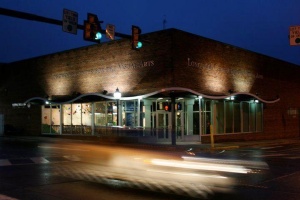 The LCVA is a 20,000-square-foot exhibition center featuring two rotating galleries that have shown works of worldwide importance, including the award-winning Reflecting Centuries of Beauty: The Rowe Collection of Chinese Art, the nationally traveled Pre-Columbian Art from the Mississippi Museum of Art, and a steady stream of solo and group exhibitions for nationally known artists such as Faith Ringgold, Jaune Quick-to-See Smith, Lesley Dill, David Macaulay, and Kojo Griffin.
The LCVA is a 20,000-square-foot exhibition center featuring two rotating galleries that have shown works of worldwide importance, including the award-winning Reflecting Centuries of Beauty: The Rowe Collection of Chinese Art, the nationally traveled Pre-Columbian Art from the Mississippi Museum of Art, and a steady stream of solo and group exhibitions for nationally known artists such as Faith Ringgold, Jaune Quick-to-See Smith, Lesley Dill, David Macaulay, and Kojo Griffin.
The LCVA also dedicates one gallery to a permanent exhibition of stunning African art, part of the Ziegler and Brumfield Collections of African Art. In 1997 Robert Ziegler, a longtime resident of Africa, established this collection with twenty-six important pieces. In 1999, Thomas and Donna Brumfield donated an additional eighty-eight works of African art. The collection includes an impressive array of statues, masks, drums, baskets, and garments, covering four geographical areas, twelve countries, and twenty-seven cultures. A catalog of this collection, Telling Objects: African Art from the Permanent Collection of the Longwood Center for the Visual Arts, is available.
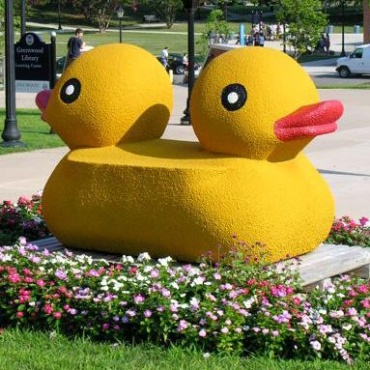 Established in 2004, Longwood University’s Brock Commons Outdoor Sculpture Program has prominently placed on campus a variety of sculpture by nationally known artists. Each piece is selected by a committee of graduating art students. The sculptures come to campus for a two-year period, assuring that a variety of form, style, and content will be represented over the course of several years.
Established in 2004, Longwood University’s Brock Commons Outdoor Sculpture Program has prominently placed on campus a variety of sculpture by nationally known artists. Each piece is selected by a committee of graduating art students. The sculptures come to campus for a two-year period, assuring that a variety of form, style, and content will be represented over the course of several years.
Featured artists have included Carl Billingsley (Greenville, NC), Kendall Buster (Richmond, VA), Kathleen Driscoll (Medford, MA), Be Gardiner (West Jefferson, NC), Brece Honeycutt (Washington, DC), Tripp Jarvis (Greenville, NC), Hanna Jubran (Greenville, NC), Rob Neilson (Appleton, WI), Foon Sham (Springfield, VA), Lucy Slivinski (Chicago, IL), Sandy Willcox (Farmville, VA), and Joyce Zarins (Amesbury, MA).
The sculpture program’s purpose is to bring to campus contemporary art and artists to foster intellectual discourse and illuminate the creative process, and to provide an aesthetic environment in which the visual arts can be appreciated on a daily basis. Each semester two artists complete a residency during which they install their work with students and present collateral lectures and workshops for Longwood classes and student groups.
The Brock Commons Sculpture Program is made possible by the Longwood University Art Department, the Longwood Center for the Visual Arts, the Office of the Provost and Vice President for Academic Affairs, and the Office of Facilities Management.
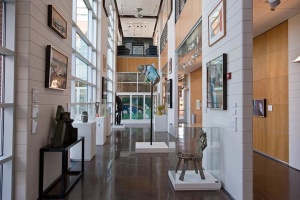 Longwood University’s most recent building, the Center for Communications Studies & Theatre opened in September 2009. An added attraction in the Center is The Jack Blanton Gallery, which features more than 160 of the 230 pieces of artwork donated by Jack Blanton in 2006. Blanton, former chairman of the LCVA Advisory Board, is a retired Federal Reserve Bank of Richmond vice president who lives in North Palm Beach, Fla. The artwork, described as widely eclectic with a contemporary focus, features a variety of Virginia artists along with nationally known talent in media such as sculpture, painting, prints, and drawings. Following the renovations of adjoining Bedford Hall, an outdoor sculpture garden will house many of the large-scale, three-dimensional works from the Blanton Collection.
Longwood University’s most recent building, the Center for Communications Studies & Theatre opened in September 2009. An added attraction in the Center is The Jack Blanton Gallery, which features more than 160 of the 230 pieces of artwork donated by Jack Blanton in 2006. Blanton, former chairman of the LCVA Advisory Board, is a retired Federal Reserve Bank of Richmond vice president who lives in North Palm Beach, Fla. The artwork, described as widely eclectic with a contemporary focus, features a variety of Virginia artists along with nationally known talent in media such as sculpture, painting, prints, and drawings. Following the renovations of adjoining Bedford Hall, an outdoor sculpture garden will house many of the large-scale, three-dimensional works from the Blanton Collection.
The building was designed with art in mind, and the theatres’ box office adjoins a dramatic two-story atrium where ticketholders can enjoy the art as they wait for performances. Art hangs in tiers in the atrium, and it also graces the corridors of the buildings as well as a number of seating areas. Represented artists include Maurice Beane, Nell Blaine, Richard Carlyon, Gene Davis, Jerry Donato, Harriet Fitzgerald, Steven Glass, Mary Holland, Kris Iden, A. B. Jackson, Ann Lyne, Henrietta Near, Paula Owen, Rubin Peacock, Julia Pfaff, Laura Pharis, Theresa Pollak, Milo Russell, Foon Sham, Conway Thompson, Ludwig Mies van der Rohe, and Willie Anne Wright.
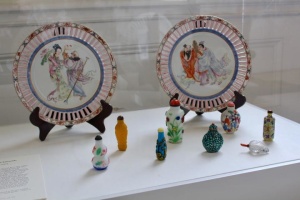 Eason Hall is the primary administration building for Longwood University and houses the exhibit containing selected objects from the Rowe Collection of Chinese artifacts, one of the six collections of art at Longwood University. Dr. and Mrs. Henry C. Rowe (Bernice Beazley, LU ’70) of Gloucester, Virginia, have given these objects from their personal collection to enhance the academic experience for Longwood students and the surrounding community.
Eason Hall is the primary administration building for Longwood University and houses the exhibit containing selected objects from the Rowe Collection of Chinese artifacts, one of the six collections of art at Longwood University. Dr. and Mrs. Henry C. Rowe (Bernice Beazley, LU ’70) of Gloucester, Virginia, have given these objects from their personal collection to enhance the academic experience for Longwood students and the surrounding community.
Several characteristics make this collection unique. First is the broad span of time from which the pieces date: as early as the Neolithic period, and as modern as the twentieth century. Nearly every dynasty is represented, with gaps existing only when historical circumstances dictate the scarcity of available artifacts. Second is the extreme rarity of many of the objects, of which some may not even have an equally rare counterpart in any other Western museum.
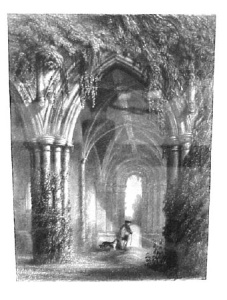 In Grainger Hall, where students study modern languages and literature, the walls feature a collection of 19th-century prints, most of which were given to the university by Mary Kossuth Shumate and by Homer “Kip” Kephart in memory of Bobby Chandler. From steel engravings made for a tourists’ guide to Versailles, to an architect’s sketches of Spanish buildings, to a set of prints reproducing “world-famous pictures” from the 18th and 19th centuries that perfectly reflect late Victorian tastes, the art in this collection fittingly evokes the cultures and the history of Europe.
In Grainger Hall, where students study modern languages and literature, the walls feature a collection of 19th-century prints, most of which were given to the university by Mary Kossuth Shumate and by Homer “Kip” Kephart in memory of Bobby Chandler. From steel engravings made for a tourists’ guide to Versailles, to an architect’s sketches of Spanish buildings, to a set of prints reproducing “world-famous pictures” from the 18th and 19th centuries that perfectly reflect late Victorian tastes, the art in this collection fittingly evokes the cultures and the history of Europe.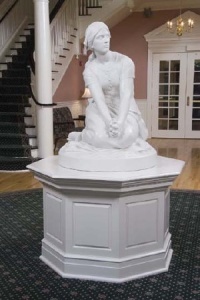 Since its founding, Longwood has reminded its community of the honor and accomplishments achieved by its leaders through portraiture depicting its presidents and outstanding faculty. Many of these portraits can be found in Rotunda Hall, along with two watercolors by Christopher Register of Longwood’s art department, a gift from the University of Virginia commemorating the rededication of the Rotunda following the calamitous fire of 2001.
Since its founding, Longwood has reminded its community of the honor and accomplishments achieved by its leaders through portraiture depicting its presidents and outstanding faculty. Many of these portraits can be found in Rotunda Hall, along with two watercolors by Christopher Register of Longwood’s art department, a gift from the University of Virginia commemorating the rededication of the Rotunda following the calamitous fire of 2001.
Additionally, Rotunda Hall is home to not one, but two, statues of Joan of Arc, a patron saint of Longwood since its years as an all-female teachers’ academy. Joan of Arc in Domrémy is on permanent display in the Rotunda. Affectionately known to the Longwood community as “Joanie on the Stonie,” this statue was purchased as a gift to the school by the Class of 1914. It is a plaster cast made by the Boston firm of Caproni Brothers after Henri-Michel-Antoine Chapu’s Joan of Arc in Domrémy, a work honored at the 1870 Paris Salon.
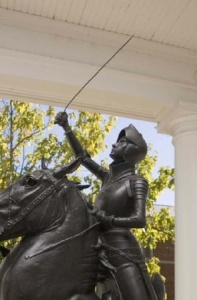 The other Joan of Arc sculpture is a reduced version of the bronze 1915 monument Joan of Arc by Anna Vaughn Hyatt Huntington (1876-1973), one of the foremost American sculptors of the early 20th century. Popularly known as “Joanie on the Pony,” Longwood’s copy, based on a casting of that monument in New York City, was given by Huntington to the college in 1927 at the request of the students. “The monument is considered one of the finest equestrian monuments in the United States,” said Robin Salmon, vice president and curator of collections at Brookgreen Gardens, Huntington’s summer home. “It’s the first equestrian monument of a woman by a woman.” Huntington’s Joan has traditionally been on display in the Colonnades.
The other Joan of Arc sculpture is a reduced version of the bronze 1915 monument Joan of Arc by Anna Vaughn Hyatt Huntington (1876-1973), one of the foremost American sculptors of the early 20th century. Popularly known as “Joanie on the Pony,” Longwood’s copy, based on a casting of that monument in New York City, was given by Huntington to the college in 1927 at the request of the students. “The monument is considered one of the finest equestrian monuments in the United States,” said Robin Salmon, vice president and curator of collections at Brookgreen Gardens, Huntington’s summer home. “It’s the first equestrian monument of a woman by a woman.” Huntington’s Joan has traditionally been on display in the Colonnades.
The International Students Lounge in East Rotunda houses a selection of works from or inspired by ancient and modern European and Asian cultures.
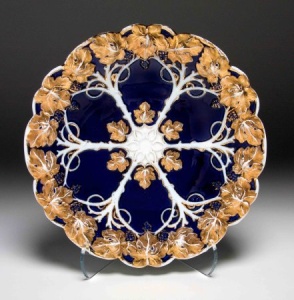 The Waverly Manson Cole Collection comprises more than 500 pieces of beautiful 19th-century Bohemian and European glass, English pottery and Meissen porcelain. Highlights from the collection are exhibited in the Cole Gallery located between Ruffner and Blackwell halls on the Longwood University campus.
The Waverly Manson Cole Collection comprises more than 500 pieces of beautiful 19th-century Bohemian and European glass, English pottery and Meissen porcelain. Highlights from the collection are exhibited in the Cole Gallery located between Ruffner and Blackwell halls on the Longwood University campus.
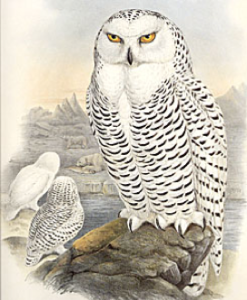 Opened in 2006, Longwood’s Chichester Science Center shatters the left brain/right brain dichotomy with its own permanent art collection. Celebrating the interaction between art and science, the exhibition features ninety works selected for both their quality and their relevance to a discipline taught in the science department. The art ranges in format from traditional to contemporary and in tone from serious to jovial, while the subject matter explores aspects of ecology, biology, chemistry, physics, botany, and geography.
Opened in 2006, Longwood’s Chichester Science Center shatters the left brain/right brain dichotomy with its own permanent art collection. Celebrating the interaction between art and science, the exhibition features ninety works selected for both their quality and their relevance to a discipline taught in the science department. The art ranges in format from traditional to contemporary and in tone from serious to jovial, while the subject matter explores aspects of ecology, biology, chemistry, physics, botany, and geography.
Notable artists include John James Audubon and Robert Smithson, among others. Virginia artists and Longwood’s own past and current faculty and alumni also feature heavily, including Marty Brief, Anna Cox, Abraham Lincoln Criss, Susan Eder, Pam Fox, David Freed, Jim Knipe, Nancy Leitch, David Lewis, Annie Lee Ross, Tanja Softić, Bob Swain, and John Williams. Williams, of Longwood’s art department, collaborated with Dr. Edward Kinman of the geography department to create a work in glazed ceramic depicting local land use changes over time.


